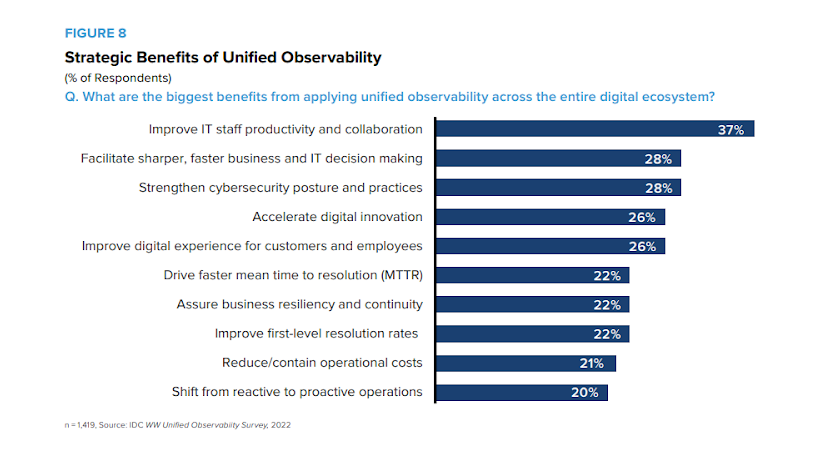Anyone doing research on observability has seen that it’s in the early stages of formation: definitions are unclear, with vendors staking their claim on the market by bending the definition to showcase their solution. There is a degree of “observability-washing” as software and service providers use the term to describe elements of it, such as logging or automated alerts. Then there are the organizational aspects to clarify: Who owns it? Who does it? Who pays for it?
Even more fundamental is the disagreement over what we are observing–applications, infrastructure, data, network, or all of the above. One thing is clear though, observability is a top area for technology investments in the coming years.
As we try to understand observability and see what it means for our own organizations, taking a look at some of the facts and stats will shed some much-needed light on this evolving and essential area.
Areas we are highlighting here include:
- Adoption
- Impact
- Organizational Structure
- Technology
Observability Stats on Adoption in the Enterprise
- The observability market is forecasted to reach $2B by 2026, growing from $278M in 2022 (650 Group, 2022)
- 90% of IT professionals believe observability is important and strategic to their business, but only 26% said their observability practice was mature. 50% are currently implementing observability. (New Relic, 2021)
- 91% of IT decision makers see observability as critical at every stage of the software lifecycle, citing the biggest benefits to planning and operations. (New Relic, 2021)
- Most ETR study respondents said they used application performance monitoring tools, with database monitoring tools coming a distant second. Digital experience monitoring was the least common use case. (ETR, 2021)
Observability Statistics on Business Impact
- Advanced observability deployments can cut downtime costs by 90 percent, keeping costs down to $2.5M annually versus $23.8 million for observability beginners. (Enterprise Strategy Group, 2022)
- These are the perceived benefits of implementing an observability practice:

- More than 70% of respondents believe that unified observability is critical to delivering the best possible digital experiences for customers and employees. (IDC, 2022) Note that digital experience monitoring was the least common use case when tools usage was surveyed. Observability to ensure availability is a critical element of CX: 40% of users will abandon a website that takes longer than three seconds to load. And 53%will abandon a mobile app that fails to load in three seconds. (Cloud Data Insights, 2022)
- Companies that have mastered observability released 60% more products or revenue streams from AppDev teams than observability beginners. (Enterprise Strategy Group, 2022)
- 75% of CISOs within financial services organizations say vulnerability management has become more difficult as the need to accelerate digital transformation has increased. (Dynatrace, 2022)
- According to Nemertes Research, an enterprise is considered successful if its MTTC is 20 minutes or less. IBM reported that the average was about 277 days. (IBM, 2022)
- Organizations using AI and automation had a 74-day shorter breach lifecycle and saved an average of USD 3 million more than those without. (IBM, 2022)
- Observability leaders report a 69% better mean time to resolution for unplanned downtime or performance degradation. (Enterprise Strategy Group, 2022)
Data on Organizational Structures
- 63% of security analysts call out lack of visibility into the network and infrastructure as a stressor. (Ponemon Research, 2021)
- Just 31% of security teams can access a fully accurate, continuously updated report of every application and code library running in production in real time. (Dynatrace, 2022)
- 39% of CIOs said that siloed teams make it harder to understand whether the IT stack is delivering the service levels that are anticipated or required for business success. (Dynatrace, 2021)
- 94% of all IT respondents, regardless of title, said that observability is important to their role. (New Relic, 2021)
- 38% of organizations report that their SecOps team uses observability tools (IDC, 2022)
- Only 25% said that Site reliability engineering used observability solutions. 57% said that IT Ops did. (IDC, 2022)
Observability Stats: Technology
- 72% noted having to toggle between at least two and 13% between ten different tools to monitor the health of their systems. (IDC, 2022)
- 35% of IT professionals said that innovation is needed in streaming data, sometimes known as observability data pipelines or observability data management. (ERA, 2022)
- 71% of companies believe their observability data (metrics, logs, traces) is growing at a concerning rate. (Enterprise Strategy Group, 2022)
- Logging data comes from a range of sources:
- 43% of organizations align observability with an ability to collect and analyze just four types of telemetry [(metrics, events, logs, traces), and 41% of organizations align observability with DevOps tools and practices for only application performance management IDC (IDC, 2022)
- 60% of IT and software engineers agree that most monitoring tools serve narrow
requirements and fail to enable a unified and complete view into current operating conditions (IDC, 2022) - 55% of organizations are using AIOps for observability for both network and security (ZK Research, 2021)
Learn more in our Observability section.
Elisabeth Strenger is a Senior Technology Writer at CDInsights.ai.



